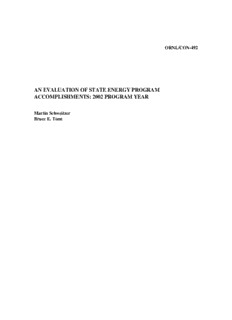Table Of ContentORNL/CON-492
AN EVALUATION OF STATE ENERGY PROGRAM
ACCOMPLISHMENTS: 2002 PROGRAM YEAR
Martin Schweitzer
Bruce E. Tonn
DOCUMENT AVAILABILITY
Reports produced after January 1, 1996, are generally available free via the U.S. Department
of Energy (DOE) Information Bridge.
Web site http://www.osti.gov/bridge
Reports produced before January 1, 1996, may be purchased by members of the public from
the following source.
National Technical Information Service
5285 Port Royal Road
Springfield, VA 22161
Telephone 703-605-6000 (1-800-553-6847)
TDD 703-487-4639
Fax 703-605-6900
E-mail info@ntis.fedworld.gov
Web site http://www.ntis.gov/support/ordernowabout.htm
Reports are available to DOE employees, DOE contractors, Energy Technology Data
Exchange (ETDE) representatives, and International Nuclear Information System (INIS)
representatives from the following source.
Office of Scientific and Technical Information
P.O. Box 62
Oak Ridge, TN 37831
Telephone 865-576-8401
Fax 865-576-5728
E-mail reports@adonis.osti.gov
Web site http://www.osti.gov/contact.html
This report was prepared as an account of work sponsored by
an agency of the United States Government. Neither the
United States Government nor any agency thereof, nor any of
their employees, makes any warranty, express or implied, or
assumes any legal liability or responsibility for the accuracy,
completeness, or usefulness of any information, apparatus,
product, or process disclosed, or represents that its use would
not infringe privately owned rights. Reference herein to any
specific commercial product, process, or service by trade
name, trademark, manufacturer, or otherwise, does not
necessarily constitute or imply its endorsement,
recommendation, or favoring by the United States
Government or any agency thereof. The views and opinions
of authors expressed herein do not necessarily state or reflect
those of the United States Government or any agency thereof.
ORNL/CON-492
AN EVALUATION OF
STATE ENERGY PROGRAM ACCOMPLISHMENTS:
2002 PROGRAM YEAR
Martin Schweitzer
Bruce E. Tonn
Date Published: June 2005
Prepared for
U.S. Department of Energy
Office of the Weatherization and Intergovernmental Program
Budget Activity Number WI 04 02 00 0
Prepared by
OAK RIDGE NATIONAL LABORATORY
Oak Ridge, Tennessee 37831
Managed by
UT-BATTELLE
for the
U.S. DEPARTMENT OF ENERGY
under contract DE-AC05-00OR22725
CONTENTS
Page
LIST OF FIGURES.............................................................................................................v
LIST OF TABLES ...........................................................................................................vii
ABBREVIATIONS, ACRONYMS, AND INITIALISMS ...............................................ix
EXECUTIVE SUMMARY ..............................................................................................xi
1. INTRODUCTION..........................................................................................................1
PROGRAM DESCRIPTION.................................................................................1
SEP PERFORMANCE METRICS........................................................................1
SCOPE OF REPORT.............................................................................................5
2. METHODS.....................................................................................................................7
DATA COLLECTION...........................................................................................7
CALCULATING SAVINGS AND EMISSIONS REDUCTION..........................8
3. HOW TO INTERPRET THE ENERGY SAVINGS ESTIMATES.............................13
FACTORS INFLUENCING UNCERTAINTY OF RESULTS...........................13
COMBINED EFFECTS OF UNCERTAINTY FACTORS.................................15
4. PROGRAM FUNDING AND ACTIVITIES ..............................................................17
FUNDING BY PROJECT AREA........................................................................17
OVERALL FUNDING........................................................................................18
STATE ACTIVITIES BY PROJECT AREA......................................................19
KEY OUTPUTS...................................................................................................20
5. ENERGY AND COST SAVINGS AND EMISSIONS REDUCTION.......................23
SAVINGS AND EMISSIONS REDUCTIONS BY PROJECT AREA...............23
TOTAL SAVINGS AND EMISSIONS REDUCTIONS.....................................25
6. SUMMARY AND CONCLUSIONS...........................................................................27
SUMMARY OF FINDINGS................................................................................27
CONCLUSIONS..................................................................................................28
7. REFERENCES ............................................................................................................31
8. ACKNOWLEDGMENTS ...........................................................................................39
APPENDIX A — DEVELOPMENT OF ENERGY-SAVINGS COEFFICIENTS.........41
MASS MEDIA.....................................................................................................41
SCHOOL EDUCATION PROGRAMS...............................................................44
WORKSHOPS AND TRAINING.......................................................................45
RETROFITS.........................................................................................................48
ENERGY AUDITS..............................................................................................51
iii
CONTENTS (continued)
Page
APPENDIX A (continued)
PROCUREMENT OF ENERGY-EFFICIENT PRODUCTS..............................53
TECHNICAL ASSISTANCE..............................................................................54
LOANS AND GRANTS......................................................................................55
CODES AND STANDARDS..............................................................................57
RATING AND LABELING................................................................................59
HOME ENERGY RATING SYSTEMS (HERS) AND ENERGY EFFICIENCY
MORTGAGES (EEMs)...................................................................................60
FINANCIAL INCENTIVES................................................................................61
INTEREST REDUCTION PROGRAMS............................................................62
ALTERNATIVE ENERGY.................................................................................62
TAX CREDITS....................................................................................................64
TRAFFIC SIGNALS AND CONTROLS............................................................65
CARPOOLS AND VANPOOLS.........................................................................66
APPENDIX B — METHOD FOR CALCULATING EMISSIONS REDUCTIONS......69
iv
LIST OF FIGURES
Figure Page
ES.1. Estimated annual nationwide energy savings by project area................................xiv
ES.2. Estimated annual energy and cost savings per dollar of funding...........................xvi
1. Calculating energy and cost savings for a single project area in a single state..........9
2. Estimated annual nationwide energy and cost savings for 17 project areas
combined................................................................................................................28
v
LIST OF TABLES
Table Page
ES.1. Estimated relative magnitude of state-reported funding, by project area................xii
ES.2. Estimated total annual nationwide energy and cost savings for combined
project areas..........................................................................................................xv
1. SEP project areas and performance metrics...........................................................2
2. Reported expenditures of funds, by project area..................................................17
3. Number of states reporting activities in each project area ...................................20
4. Key SEP outputs, by project area ........................................................................21
5. Estimated annual nationwide energy and cost savings, by project area ...............23
6. Estimated annual nationwide emissions reductions, by project area ....................24
7. Estimated annual nationwide funding and savings for combined project areas....25
A.1. Estimated energy savings from commercial sector training programs .................47
A.2. Estimated energy Savings from Rating and Labeling...........................................60
B.1. Emissions from each major fuel type, in metric tons per million source BTUs....70
B.2. Fuel mix for key energy use sectors or activities...................................................71
B.3. Average emissions for key energy use sectors or activities, in metric tons per
million source BTUs...........................................................................................72
vii
Description:Reports are available to DOE employees, DOE contractors, Energy Technology Data. Exchange (ETDE) representatives, and International Nuclear

